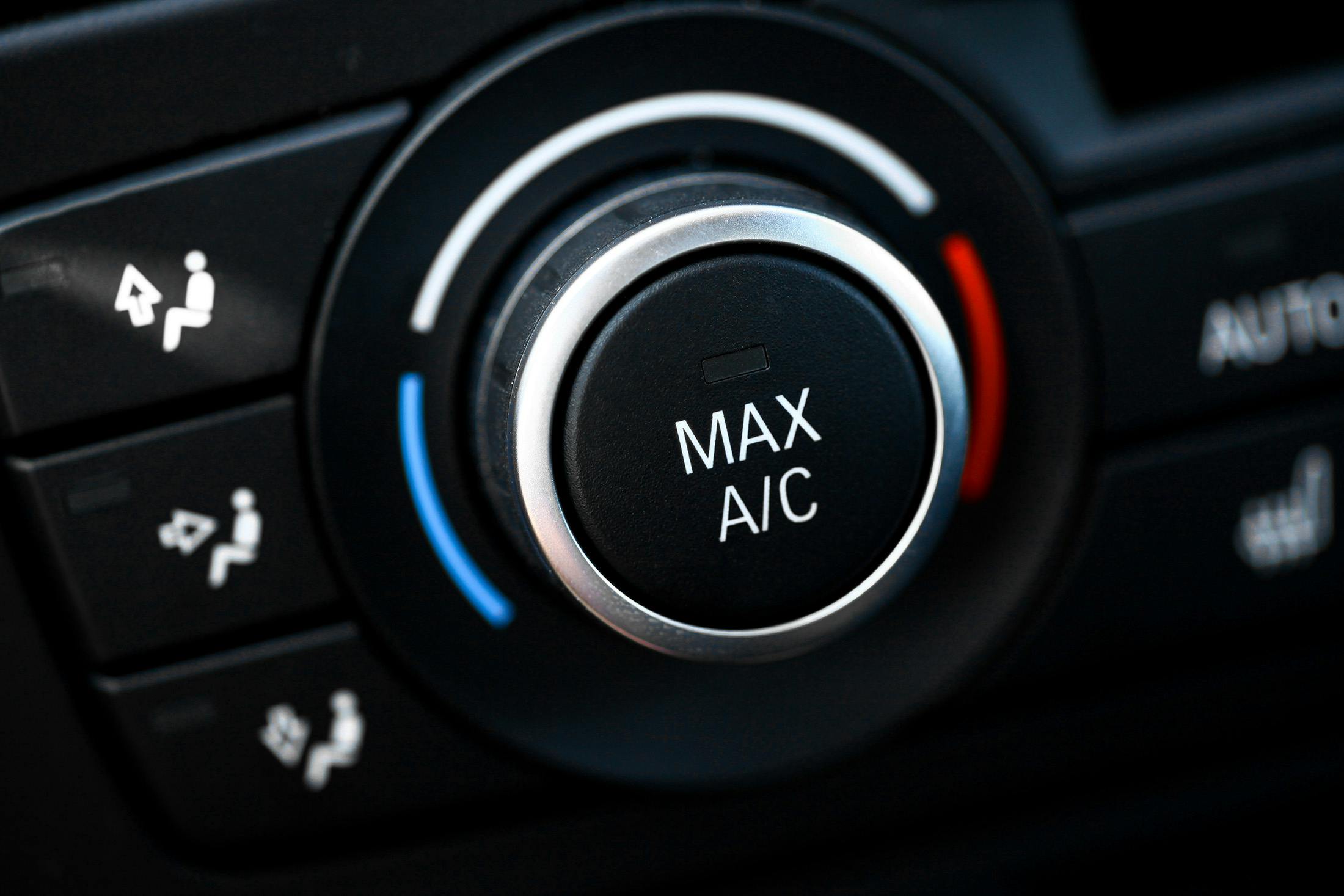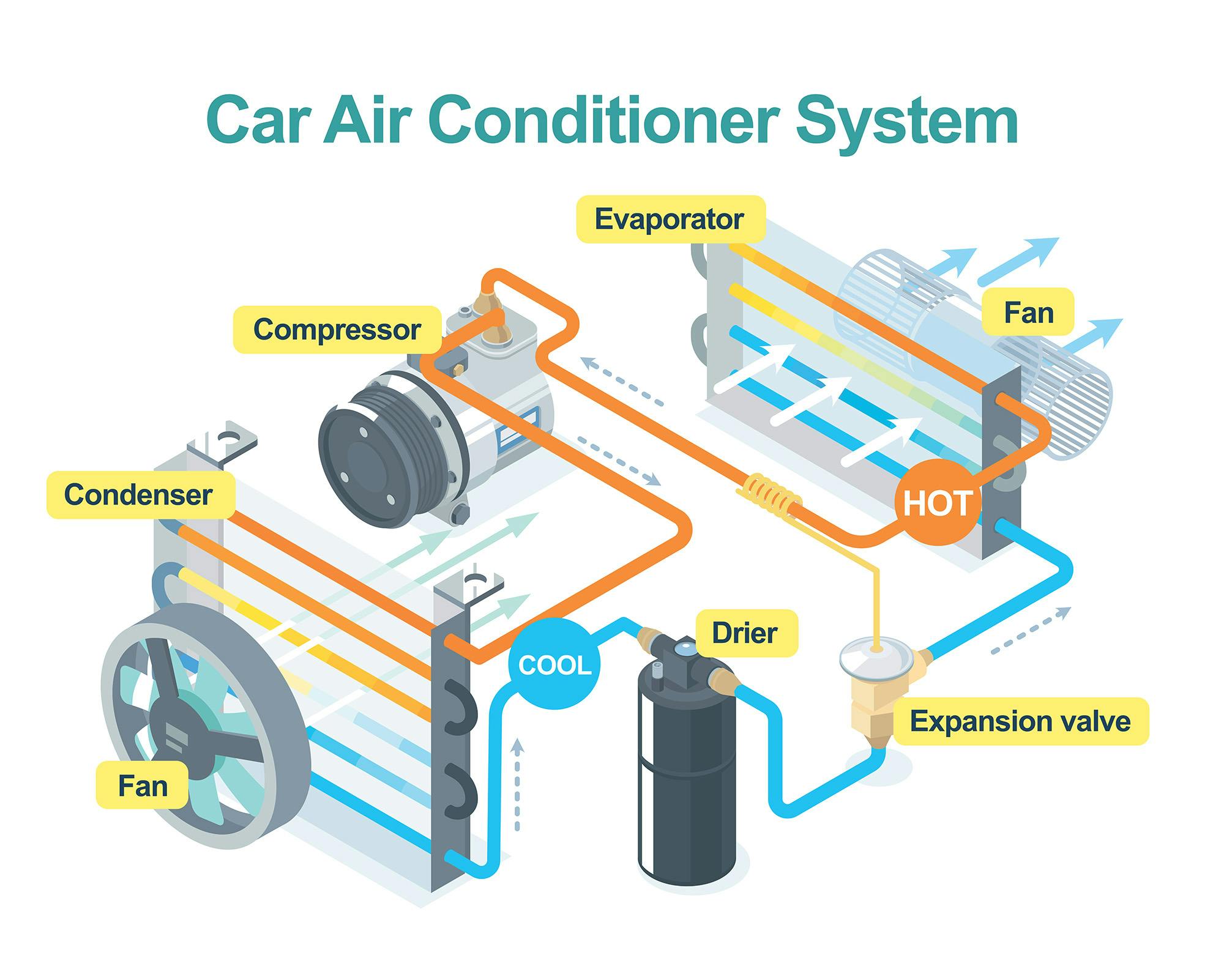How does car air-conditioning work?

How often do you think about how your car's air conditioning system works? Do you just switch the air conditioner on and trust that it will work? If it does not work, do you just visit the nearest car air conditioning service centre and ask them to regas the air conditioning system?
Many car owners don’t realise just how complex modern, computer-controlled car air conditioning systems have become. In fact, the old methods of testing and diagnosing car air conditioning systems no longer work to find and fix problems in modern climate control systems.
In this guide, we explain how car air conditioning systems work, and why they fail. We will also answer all the other questions you have always wanted to ask about the air conditioning system in your car. Let us start by answering this question-
How does a car’s air conditioning system work?

This diagram shows the basic layout of a typical car air conditioning system. The orange lines show where the hot refrigerant flows, while the blue lines show where the cold refrigerant flows. This basic layout largely applies to all air conditioning systems. The air conditioning systems in our homes, shops, factories, and even our domestic refrigerators and freezers all look like this.
Moreover, all the components that make up a car air conditioning system also work just like the components in other systems do. However, before we explain what each component in the system does, we need to explain-
How refrigerant works
Although the refrigerant circulates throughout the A/C system when it is working, the refrigerant changes from a gas to a liquid at different points in the system. As a practical matter, the refrigerant cools down a lot when it changes into a gas, and it heats up a lot when it changes back into a liquid.
When the A/C system is on, the refrigerant circulates throughout the system, which is designed to keep the hot liquid and the cold gas in different parts of the system. Thus, the A/C system will produce cold air for as long as it is working. Nonetheless, for the system to work properly, it-
- must have enough of the correct refrigerant gas available to circulate through the system, and
- the refrigerant must be at a specific pressure to produce the desired cooling effect when it changes into a gas
So now that we understand the basics of how a car air conditioning system works, let us look at what each of the components in the system does. Let us start with-
The compressor
The compressor is the driving force that circulates the refrigerant gas through the A/C system. It contains several pistons that compress the liquid refrigerant before forcing the hot liquid into the rest of the system. On most cars, the compressor is driven by the engine via a drive belt and an electromagnetic clutch. Note though that on electric and most hybrid vehicles, the compressor is driven by an electric motor.
The condenser
The condenser works just like the radiator in the engine cooling system. As the hot, liquid refrigerant passes through a series of small tubes in the condenser, it cools down and begins to change into a gas.
Condensers are typically located just behind the grille and are fitted with electric cooling fans. This is to ensure that it is exposed to the best possible airflow to cool down the hot refrigerant more quickly.
The drier
This part is also known as a "receiver". When the refrigerant enters the receiver, it is a mixture of gas and liquid. However, since the drier has a large volume, the refrigerant cools down rapidly when it leaves the drier.
As a practical matter, this part is called the “drier” because it contains a powder that absorbs any moisture that may be present in the refrigerant.
The expansion valve
This part is also sometimes known as an “orifice tube”. Here is why it is one of the most important parts of any air conditioning system-
All air conditioning systems work because they are all based on one particular scientific law. This law states that any gas that is under pressure will cool down when it is vented into a larger volume.
In practice, the expansion valve separates the A/C system into two parts. On the one side, the refrigerant is under pressure, although it has almost fully changed into a gas. On the other side of the expansion valve, the pressure in the system drops as the refrigerant gas passes through the expansion valve..
The hole in the expansion valve is very small. As a result, it allows only a small amount of pressurised refrigerant to pass through it into the larger volume of-
The evaporator
When the refrigerant passes through the expansion valve, it enters the larger volume of the evaporator that is enclosed in a kind of box. At this point, the refrigerant fully turns into a gas, and it cools down a lot in the evaporator because it is now at a lower pressure.
The cold refrigerant cools down the coils of the evaporator, which then cools down the air around the evaporator. This cool air is then forced into the air conditioning systems’ pipes by an electric fan to enter the passenger cabin through vents. As the refrigerant gas leaves the evaporator, it begins to heat up again as it returns to the compressor to begin a new cycle.
The sections above describe the basic operation of a car’s air conditioning system, but the thermostat and pressure switches are not shown on the diagram. These parts are important, so let us describe their function, starting with-
The thermostat
The thermostat measures the temperature of the cold air that leaves the evaporator. If the A/C system works correctly, the thermostat keeps the cold air at the selected temperature. It does this by activating or deactivating the clutch that controls the operation of the compressor. This is called “cycling”, and is a normal part of the cooling cycle.
Pressure switches
Pressure switches in the high-pressure side of the system monitor the pressure in this part of the air con system to protect the compressor. Because the refrigerant gas contains oil to lubricate the compressors’ moving parts, the compressor can suffer fatal damage if it should start without lubrication being available.
Thus, in practice, the pressure switches will prevent the compressor clutch from engaging when the pressure in the high-pressure side of the air conditioning system drops too low. When this happens, the A/C control system assumes that no lubrication is available based on the absence of pressure in the system.
